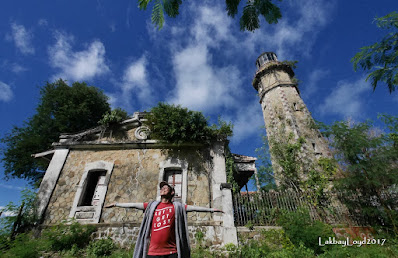My search for the elusive historic Spanish colonial lighthouses in the Philippines finally came to an end as I put a mark on the last lighthouse on my list - El Faro De Cabo Melville or the Cape Melville Lighthouse. It was constructed by the Spaniards to light Balabac Strait as part of their extensive lighting plan for the archipelago. The construction began in 1818 and took 74 years to finish. It was first lit on August 30, 1892. It is conical in form rather than cylindrical, and share the same architectural design as the Cape Bojeador Lighthouse in Burgos, Ilocos Norte. The lighthouse is intact but in need of restoration.
It was a long time wish for me to visit the Cape Melville Lighthouse when I created the list in 2013. With limited information, I had to do a lot of research and preparation for that ultimate adventure down the final frontier in the Last Frontier. Cape Melville Lighthouse is located in the farthest tip of Balabac Island, the southernmost island in the province of Palawan, known as the Philippines' Last Frontier. The lighthouse is a first-order light constructed by the Spaniards to guide vessels crossing the Balabac Strait, the treacherous body of water that separates the Philippines from Malaysia.
I didn't have the luck during my first visit to the island in November 2016 due to time constraints, inappropriate weather condition, and of course, the luck. It was until my second visit to the island in September 2017, almost a year after my first attempt, that I finally conquered Cape Melville.
Going to Balabac is not that simple. It will take one whole day from Puerto Princesa City if you go non-stop to get there. And the total fare is not cheap. The fares are P400 for the van going to Rio Tuba and P350 for the ferry going to Balabac.
First, you have to take the 4am van from the hotel (Lexxus, Palshutex, etc. offer passenger pickup from any hotel) or from Puerto Princesa's San Jose Terminal to Rio Tuba to ensure that you won't miss the ferry going to Balabac Poblacion. The trip to Rio Tuba usually takes 4 to 5 hours if you are taking the van. Next, take the ferry from Rio Tuba to Balabac Poblacion which leaves at 10am and takes around 4 hours. Depending on the number of passengers, the ferry leaves earlier or later as scheduled. There's only one ferry trip going in and out of Balabac Island daily and you'll have to wait for the next day to sail if you miss one.




Balabac is another off-the-beaten-track destination which is slowly getting attention from tourists. Consisting of 36 islands, mostly unexplored islands but exclusive, Balabac offers a once in a lifetime experience for those who are hungry for a 'real-out-there' travel adventure. There are tour operators offering visits to the islands, but for a cost - ranges from P4000 to P6000 depending on the size of the boat. Being solo, I opted not to go on island hopping as my primary agenda is to go to the lighthouse.
Balabac is an unperturbed town where everything is simple, completely untouched by commercialization and tourism. Do not expect any grandeur accommodation or posh restaurants as you won't find any. Electricity is not 24/7, usually available only from 2pm til 12 midnght. No internet nor mobile data but only cellular signal is available - no social media at all!
I stayed at the JD Inn - Sing and Swing Lodge during my Balabac trips. It's the only popular place to stay in town and a few minutes away from the port by walking. Depending on your budget, there are fan rooms (P500 I think) and aircon rooms for P1000 a night. They have generators and alternatively, the fan in the room will turn on when the electricity was cut and aircon shut off.
I found out that there are two options to get to the lighthouse. One is to arrange a boat to take you to Cape Melville which will cost you around 3,000 - 4,000 pesos. The other, take a habal-habal which will only cost you 1.000 to 1.500 pesos. I chose the latter.
Kuya Jo, the caretaker of Sing and Swing advised me to hire an expert driver since there is no road going to Cape Melville by any vehicle, even habal-habal. Prepare to get dirt and mud on your clothes as you will endure to bike and hike and cross carabao pools for 3 hours. True enough, I had to endure several falls in the mud before we really got close to the lighthouse.
We had to go on a short hike to the lighthouse as it was located on top of a hill in the middle of a field and through coconut grove and bushes and hedges. The 3-hour habal-habal ride was already formidable but it was a sight of relief for me to see the imposing structure even from afar. It is definitely an architectural gem.
The Cape Melville Lighthouse is no longer in service and a white aluminium prefabricated tower with modern solar-powered light was erected near the grounds of the old tower by the Philippine Coast Guard. Because the station is manned by the Philippine Navy, the original lights and lenses are still intact except for a central glass pane which was stolen by vandals. The tower still retains its original clockwork but is inoperative. It was declared as a National Historical Landmark by the National Historical Commission of the Philippines.
Getting to Cape Melville was exciting, dangerous, and breathtaking. It is the ultimate completion of a plan borne out of curiosity and impulsive decisions. But the real fulfilment comes from looking back and seeing all the people who helped you, put their trust on you, strange people you came across with, people who believed in you. people who walked with you and helped you as you struggle over every obstacle along the way, sharing the same feeling of excitement and fulfilment as you reached the destination together.



















































